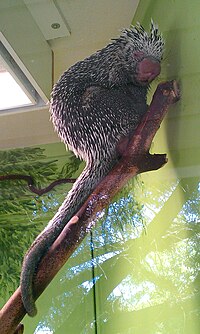Prehensile-tailed porcupine
| Prehensile-tailed porcupines Temporal range: Early Pleistocene to Recent[1]
| |
|---|---|

| |
Coendou prehensilis
| |
| Scientific classification | |
| Domain: | Eukaryota |
| Kingdom: | Animalia |
| Phylum: | Chordata |
| Class: | Mammalia |
| Order: | Rodentia |
| Family: | Erethizontidae |
| Subfamily: | Erethizontinae |
| Genus: | Coendou Lacépède, 1799 |
| Type species | |
Hystrix prehensilis | |
| Species | |
|
See text | |
The prehensile-tailed porcupines or coendous (genus Coendou) are found in
polyphyletic, while Echinoprocta nested within Coendou.[5]
Characteristics
Among the most notable features of Coendou porcupines are their unspined
adept climber, an adaptation to living most of their lives in trees.[6]
They feed on leaves, shoots, fruits, bark, roots, and buds. They can be pests of plantation crops.[6] They also make a distinctive "baby-like" sound to communicate in the wild.
Their young are born with soft hair that hardens to quills with age. Adults are slow-moving and will roll into a ball when threatened and on the ground. The record longevity is 27 years.[7]
Species
- Genus Coendou - prehensile-tailed porcupines[5]
- Baturite porcupine - C. baturitensis - a newly discovered species[8][9][10]
- Bicolored-spined porcupine - C. bicolor
- Streaked dwarf porcupine - C. ichillus
- Bahia porcupine - C. insidiosus
- Black-tailed hairy dwarf porcupine - C. melanurus
- Mexican hairy dwarf porcupine - C. mexicanus
- Black dwarf porcupine - C. nycthemera
- Amazonian long-tailed porcupine - C. longicaudatus
- Brazilian porcupine - C. prehensilis
- Frosted hairy dwarf porcupine - C. pruinosus
- Andean porcupine - C. quichua
- Roosmalen's dwarf porcupine - C. roosmalenorum
- Stump-tailed porcupine - C. rufescens
- Santa Marta porcupine - C. sanctamartae
- C. speratus - a newly discovered species[11]
- Paraguaian hairy dwarf porcupine - C. spinosus
- Brown hairy dwarf porcupine - C. vestitus
References
- ^ "Coendou in the Paleobiology Database". Fossilworks. Retrieved 2019-03-09.
- OCLC 62265494.
- OCLC 62265494.
- OCLC 62265494.
- ^ S2CID 55426177.
- ^ a b Nowak 1999
- ^ Gorbunova, Bozzella & Seluanov 2008
- ^ Feijó, Anderson; Langguth, Alfredo (2013-09-12). "A new species of porcupine from the Baturité range". Revista Nordestina de Biologia. 22 (1/2): 124–126.
- ^ "New Discovery: Porcupine Species Identified in Brazil". National Geographic. 2013-12-10. Archived from the original on December 13, 2013. Retrieved 2013-12-20.
- ^ "Coendou baturitensis: New Porcupine Discovered in Brazil". Sci-News.com. 2013-12-02. Retrieved 2013-12-20.
- PMID 26042302.
- Gorbunova, V; Bozzella, MJ; Seluanov, A (September 2008). "Rodents for comparative aging studies: from mice to beavers". Age (Dordr). 30 (2–3): 111–119. PMID 19424861.
- Nowak, Ronald M (1999). Walker's Mammals of the World (6th ed.). Johns Hopkins University Press. ISBN 0-8018-5789-9.
- Woods, C.A.; Kilpatrick, C.W. (2005). "Infraorder Hystricognathi". In OCLC 62265494.
